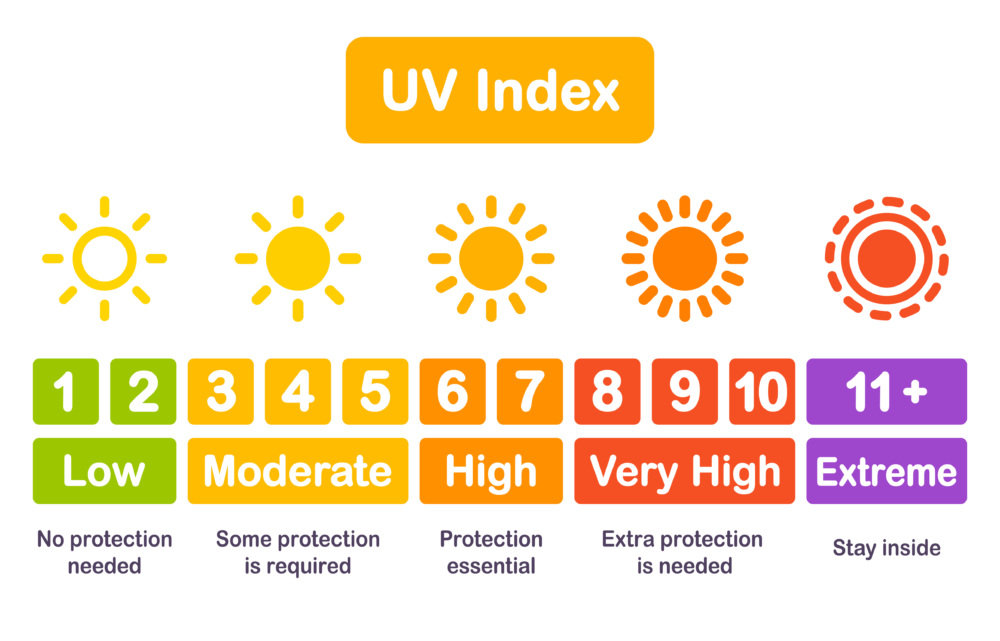Clearing the haze about the UV Index

Have you ever seen the phrase “UV Index” and thought to yourself, “What in the world is that?”
Most skin cancers are caused by the sun’s ultraviolet (UV) rays, but you can use the UV Index to reduce your risk of cancer and keep your skin healthy. July is UV Awareness Month, so there’s no better time to learn what the UV Index is, where to find it, and what it means for you.
What is the UV Index and how does it work?
The UV Index is a prediction of how strong UV radiation from the sun will be at a particular time and place. Using computer models, the National Weather Service calculates the UV Index in every ZIP code and assigns a number from 1 to 11+. The higher the number, the greater the risk of overexposure to the sun and the less time it will take to experience skin damage.
A UV Index of 2 or less indicates a low risk of overexposure, while numbers such as 8 to 10 (very high) and 11+ (extreme) indicate far greater risk. The scale is color-coded from green to violet, with green indicating the lowest potential for overexposure and violet indicating the most extreme. The UV Index tells you what level of UV protection you need when spending time outdoors.
Why does UV radiation and overexposure matter?
UV radiation is made up of both UVA and UVB rays. UVA rays make up about 95% of UV radiation and penetrate the layers of skin more deeply, causing premature skin aging and wrinkles. UVB rays, on the other hand, make up about 5% of UV radiation and usually affect the outermost layers of skin, leading to sunburn.
Unprotected exposure to both UVA and UVB rays can cause damage to the DNA of cells, which can lead to skin cancer. In fact, the World Health Organization (WHO) declared UV radiation a human carcinogen.
Where can I find the UV Index?
You can find the UV Index listed alongside temperature and rainfall forecasts in weather apps on your smart phone, during weather reports on the news or in the newspaper or on the Environmental Protection Agency’s SunWise app. You can also look up the UV Index on the EPA’s website or most weather-reporting websites.
If you don’t have access to technology, use the shadow rule to gauge UV exposure. When you are outside, look down at your shadow: if it is shorter than you are, the sun’s rays are strong, and your risk of UV exposure is higher. Build checking the UV Index into your routine, the same as you do choosing what to wear or deciding if you’ll need an umbrella.
How can I use the UV Index to protect my skin?
When the UV Index is low (1 or 2):
At a UV Index of 1 or 2, most people don’t have to worry too much about sun protection when spending time outdoors. But if you have fair skin, light hair or light eyes or if you have sensitive skin, it is still possible for your skin to be damaged on a day with UV indexes of 1 to 2, so take precautions.
When the UV Index is moderate to very high 3-10:
If you know that you’re going to be outside and the UV index is 3 to 10, protect yourself by wearing broad-spectrum sunscreen and lip balm (SPF 30 or higher), avoiding the sun when UV rays are at their highest (between 10 a.m. and 4 p.m.), seeking shade, and wearing protective clothing, headwear and eyewear.
When the UV Index is extreme (11+):
When the UV Index gets this high, consider staying indoors. Avoiding UV exposure at these levels will not only reduce your risk of skin damage but will also reduce your risk of skin cancer. If you do go outside, be sure to follow the precautions outlined above to protect yourself.
Heavy cloud coverage can block out most UV rays, but they can still get through when clouds are patchy—so don’t skip the sunscreen just because you see clouds in the sky.
The UV Index is higher in spring and summer and is higher in areas close to the equator or at higher altitudes—if you live in one of these places, be mindful of your increased exposure to the sun.
Learn more about skin cancer risk reduction and early detection at preventcancer.org/skin.